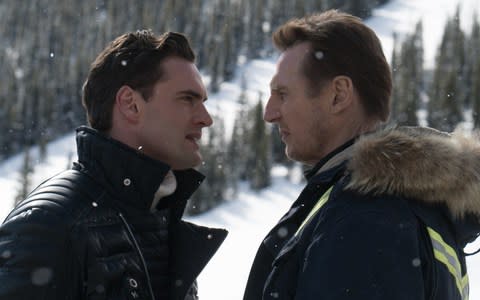Cold Pursuit review: Liam Neeson ups the body count in a ghoulishly cynical revenge thriller

Dir: Hans Petter Moland. Cast: Liam Neeson, Tom Bateman, Tom Jackson, Laura Dern, Emmy Rossum, John Doman, Domenick Lombardozzi, Arnold Pinnock, Raoul Trujillo, Ben Hollingsworth. 15 cert, 119 min
What a difference a fortnight makes. At the start of February, the frosty revenge thriller Cold Pursuit was ambling towards its release date; following the likes of Taken, it was just another entry in Liam Neeson’s dad-on-the-rampage subgenre. Now, it’s forever marked as the film that Neeson was promoting when he made an off-the-cuff confession about a racist vendetta.
It’s impossible to watch Cold Pursuit without the grim spectre of that story hovering about it, especially in the couple of scenes that Neeson shares with Arnold Pinnock, the lone black actor in the cast (playing a hapless hitman). Still, the ghoulishly cynical tone of this thing was never going to fly, not even as a set of basic popcorn thrills, let alone as some cautionary fable about the pitfalls of murderous rage.
It’s a remake of 2014’s Norwegian black comedy In Order of Disappearance, in which Stellan Skarsgård played a grieving snowplough driver called Nils Dickman, out to avenge the death of his son after an apparent heroin overdose. Neeson’s character is called Nelson Coxman – see what they did there? – and holds down the same job in the fictional American ski town of Kehoe. The reworking cracks on, conscience-free, with its identical premise, more concerned with seeming winkingly stylish and deadpan-callous, and getting the body count into double figures as briskly as it can.
The same director, Hans Petter Moland, made both films, so he can hardly complain about the guts of his original being ripped out by inferior hackwork. That said, coming three years after the Anders Breivik massacre, the Skarsgård film had some claim to be joining a national conversation about violence in Norway. Fast-forward to the present, and the only such conversation going on anywhere near Cold Pursuit is the one about Neeson himself.
And yet it’s strange how little this script decides to use him. After being informed that a criminal syndicate killed his son, Coxman comes after them, going up the chain one by one in that manner beloved of Lee Marvin in Point Blank, Michael Caine in Get Carter, or Terence Stamp in The Limey.
Merely to invoke these films is to wish that Cold Pursuit deserved the comparison, but the problem is its yawning disinterest in Coxman as a hero – let alone in his pot-smoking wife, played by an uncredited Laura Dern in one of the most thankless gigs she’s ever taken.

The film casts its net perversely wide: soon shunning the Coxmans, it devotes long reels to heaping quirky characterisation onto the villains, then the local police, and then a Native American drug cartel dragged through sheer confusion into an internecine gang war.
There’s an overload of minor characters who are up to no good, fit more for a Tarantino convention than a straightforward Neeson action flick. For instance, a pair of henchmen who are secretly gay; numerous paid enforcers including Coxman’s own brother (a decent William Forsythe); a range of badly acted wife-and-girlfriend figures who only clutter up the works.

The criminals all have try-hard nicknames (“Speedo”, “Limbo”, “Bullet”, “The Eskimo”); this is pretty tiresome even before someone remarks on how weird it all is, at which point it becomes meta-tiresome. The white syndicate boss, known as “Viking” (Tom Bateman), is a sharkish American Psycho type who loathes his ex-wife, whips his pre-teen son into shape with oppressive diets, and can’t speak a line without seething. Consistently hateful he may be, but he’s not a character who deserves anything like the indulgent airtime he gets.
Either the film has overestimated our appetite for a season’s-worth of disreputable TV baddies, converging on a long, slow Mexican stand-off, or it has lost control of its identity, heading halfway to something like Three Billboards Outside Kehoe, Colorado. While the tone smirks, sarcastic misogynists do all the talking, and Native Americans sit there looking deadly and wise.
Only so many times can the screen fade to black, naming the latest corpse with a mock-solemn RIP, before any thin amusement in this spiral of revenge ebbs away. And what are we left with? Neeson, growling through his dialogue like a man shovelling gravel. He lends an air of gloomy distraction on top. Perhaps he’s pondering past life experiences – or future encounters with the press.


